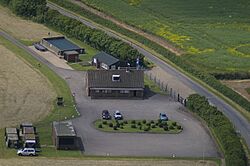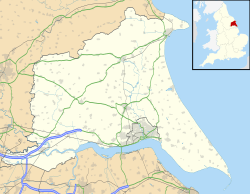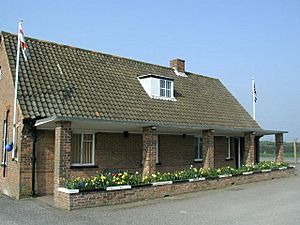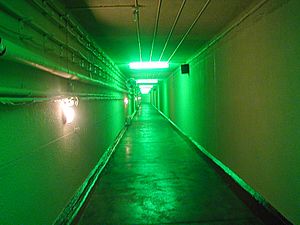RAF Holmpton facts for kids
Quick facts for kids RAF Holmpton
|
|
|---|---|
| Near Holmpton, East Riding of Yorkshire. in England | |

Aerial View of RAF Holmpton 2013
|
|
| Coordinates | 53°41′02″N 0°04′02″E / 53.6839°N 0.0673°E |
| Type | RAF Command Bunker |
| Height | 100 feet (30 m) deep excavation |
| Site information | |
| Owner | RL(FRAFS)BLC Limited |
| Controlled by | Not for Profit |
| Open to the public |
2016 – 23 March to 29 August |
| Condition | Fully maintained |
| Site history | |
| Built | 1951 |
| In use | 1953–2014 |
| Materials | Concrete/steel/tungsten |
RAF Holmpton was a secret underground bunker built in the 1950s. It was part of a plan called ROTOR to spot enemy planes during the Cold War. This bunker is near the village of Holmpton in East Riding of Yorkshire, England. It served the military for 62 years. In 2014, it was sold to private owners.
The whole area is about 36 acres (14.5 hectares). The main part is a huge bunker, 100 feet (30 meters) underground. It's like a secret city beneath your feet!
Contents
What Was the ROTOR Programme?
Building a Secret Bunker
The RAF Holmpton bunker was built between 1951 and 1953. It was designed to be an early warning radar station. This means it would detect enemy aircraft far away. The bunker was a special type called R3-M2. This was a larger version of other bunkers. RAF Holmpton was the only one of its kind in the UK. It was a test model for similar bunkers built in Europe.
The bunker is incredibly strong. It sits in a hole 100 feet (30 meters) deep. It's surrounded by 10 feet (3 meters) of solid concrete. Special tungsten rods make it even stronger. The outside is covered in brickwork and a waterproof layer. There's also a thick concrete slab above it. This "buster slab" protects the bunker from bombs. Building it cost £1.5 million in 1953. That's a lot of money!
Changes Over the Years
From 1958 to 1975, the bunker and nearby living quarters were called RAF Patrington. When the living quarters closed, the bunker site became RAF Holmpton again. In the late 1960s, it became a main Radar Station. It tested new radar systems and housed huge computers. A very tall 200-foot (60-meter) tower was used for radar. This tower was taken down in 1971. All radar work at the site stopped in 1973. For a few years, the bunker was used for training.
Command and Control Centre
A New Purpose for the Bunker
In the 1980s, the bunker got a new job. It became the emergency headquarters for RAF Support Command. This was important during the Cold War. But when the Cold War ended in 1991, this role stopped. The site went back to being used for training.
In 1994, the bunker was updated again. It became the first test headquarters for a new UK system. This system was for advanced communications in Electronic warfare. This job stayed at RAF Holmpton until 2002. The main operations room, called AREA 7, remained untouched until 2012.
Royal Observer Corps at Holmpton
Watching the Skies
For many years, the bunker also had an area for the Royal Observer Corps (ROC). The ROC was a group of volunteers. They watched for enemy aircraft and nuclear attacks. The main ROC group stopped its work in 1992. However, some ROC units stayed at Holmpton until 1995. They focused on chemical, biological, and nuclear threats. This makes RAF Holmpton one of the last places where ROC members served. It's a special part of the bunker's history.
After 1997, the site was looked after by a company. It was sometimes used for training by the RAF Regiment. In 2003, the Ministry of Defence leased the site. A public exhibition opened to visitors in 2004.
RAF Holmpton Today
From Military to Museum
In 2012, the government decided the Air Force no longer needed the site. So, in 2014, RAF Holmpton was sold to a private company. This company already had a lease for the site. Public visits continued during this change. The site then closed for a big update in 2015. It reopened to visitors on March 23, 2016.
During the COVID-19 pandemic, the bunker closed again. But in 2023, it reopened for special visits. Sometimes, original ROC volunteers are even there to share their stories!




